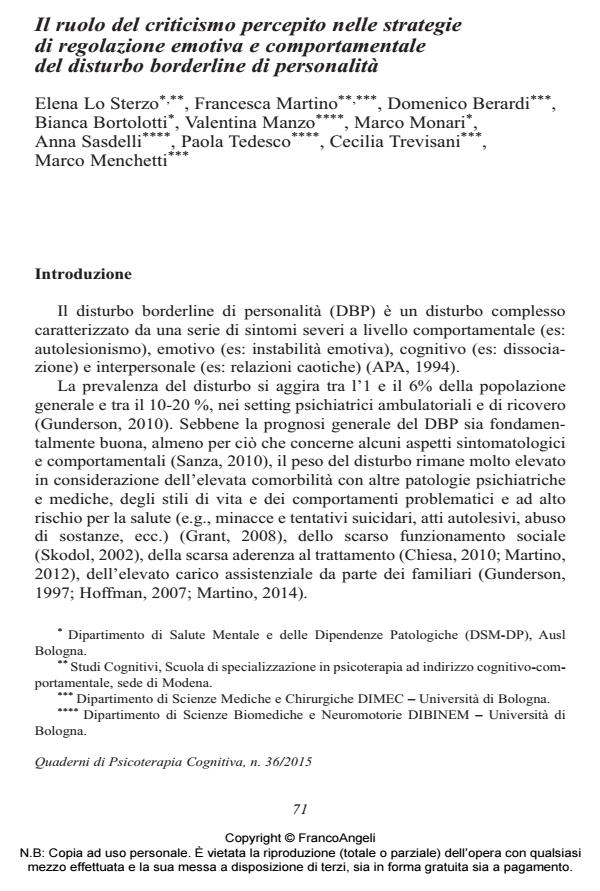The role of perceived criticism within the emotion and behavioral regulation strategies in Borderline Personality Disorder
Journal title QUADERNI DI PSICOTERAPIA COGNITIVA
Author/s Elena Lo Sterzo, Francesco Martino, Domenico Berardi, Bianca Bortolotti, Valentina Manzo, Marco Monari, Anna Sasdelli, Paola Tedesco, Cecilia Trevisani, Marco Menchetti
Publishing Year 2015 Issue 2015/36
Language Italian Pages 14 P. 71-84 File size 119 KB
DOI 10.3280/QPC2015-036006
DOI is like a bar code for intellectual property: to have more infomation
click here
Below, you can see the article first page
If you want to buy this article in PDF format, you can do it, following the instructions to buy download credits

FrancoAngeli is member of Publishers International Linking Association, Inc (PILA), a not-for-profit association which run the CrossRef service enabling links to and from online scholarly content.
The term criticism refers to the tendency of expressing disapproval and of noting the problems or faults of a person. A number of studies demonstrated that the degree of criticism perceived (CP) by patients in the familiar context predicts worse clinical outcomes in schizophrenia, in anxiety and mood disorders and in substance use disorder. According to the theoretical model by M. Linehan, in the borderline personality disorder (DBP) emotional dysregulation is caused by the pairing of two precursors: a biological emotional vulnerability and an invalidating environment. In line with this model, the present study aims to verify that: 1) in DBP patients, CP predicts emotion disregulation and dysfunctional aggressive behaviors; 2) difficulties in emotion regulation act as mediators between CP and dysfunctional behaviors. The subjects of the present research were 57 adults with DBP and 35 with other personality disorders, and they were given questionnaires assessing: Perceived Criticism, tendency to aggressiveness, tendency to act self-harm behaviors, emotional dysregulation. Results show that the content of CP predicts the tendency to aggression and selfharm in DBP patients but not in the other group. Emotional dysregulation is a partial mediator between CP content and both self-harm and aggressive behaviors. CP may be one of the predisposing factors to emergence of aggressive and self-harm behaviors in DBP patients. Difficulties in emotion regulation partially explain this relationship.
Keywords: Perceived criticism, borderline personality disorder, emotion regulation, aggression, self-harm.
Elena Lo Sterzo, Francesco Martino, Domenico Berardi, Bianca Bortolotti, Valentina Manzo, Marco Monari, Anna Sasdelli, Paola Tedesco, Cecilia Trevisani, Marco Menchetti, Il ruolo del criticismo percepito nelle strategie di regolazione emotiva e comportamentale del disturbo borderline di personalità in "QUADERNI DI PSICOTERAPIA COGNITIVA" 36/2015, pp 71-84, DOI: 10.3280/QPC2015-036006